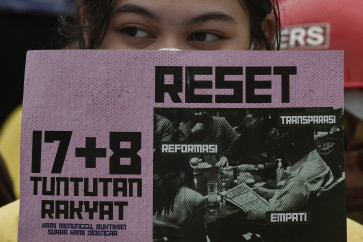Popular Reads
Top Results
Can't find what you're looking for?
View all search resultsPopular Reads
Top Results
Can't find what you're looking for?
View all search resultsPeople’s habits drive crocs closer to residential areas
Taming the wild: Local men bind the snout of a young crocodile that entered a village in Pontianak, West Kalimantan
Change text size
Gift Premium Articles
to Anyone
T
span class="caption">Taming the wild: Local men bind the snout of a young crocodile that entered a village in Pontianak, West Kalimantan. The crocodile will be sent to a local conservation agency.(JP/Severianus Endi)
More crocodiles are entering waters close to residential areas in West Pontianak, West Kalimantan, as local people are accidentally feeding them by throwing food waste, including chicken intestines, into the rivers.
The estuarine crocodile, also known as the saltwater crocodile, whose habitat is in the Kapuas River, Pontianak, is now more often seen near residential areas.
Some are kept by residents, while others are handed over to the Natural Resources Conservation Center (BKSDA) immediately after the beasts are captured.
As of June 2016, the conservation agency has relocated four estuarine crocodiles. The crocs were transported to the Sinka Zoo Conservation Institute in Singkawang, located about 151 kilometers from Pontianak.
Another relocation was conducted on Wednesday as residents came across a crocodile estimated to be about a year old that had a body length of more than a meter. It initially appeared in a boat building and repair yard in West Pontianak on Sunday.
Security guard Joni, 34, tried to drive away the protected animal, but as the crocodile did not leave Joni and his two colleagues caught it by its snout, then put it in an iron fish basket measuring about 1.5 square meters.
“After catching the crocodile, I immediately contacted the conservation agency to relocate it. We decided to catch the crocodile to prevent it from causing danger to surrounding residents,” he said.
“A few months ago, I also saw hatchlings, each measuring around 50 centimeters long around the dock, but I was able to drive them away,” Joni said, adding that the crocodile he caught was quite violent and refused to eat the fresh fish they provided.
West Kalimantan Forest Ranger chief Azmardi said changes in the condition of the ecosystem had made the crocodiles move ever closer to residential areas. The habit of people who dumped waste, such as chicken intestines, into rivers and swamps had “invited” the crocodiles.
Crocodiles, which originally looked for food by hunting other animals in the wild, now get food easier from the waste disposed by residents. Azmardi said the dumping of waste into the river, which had been going on for years, had changed the behavior of the crocodiles.
The animals are getting accustomed to being in residential areas located along the river and the swampy areas.
“Potential dangers would arise if people are unaware of the presence of the crocodiles, such as those bathing in the river. There are already incidents when residents become crocodile prey. If a young crocodile measuring less than a meter long is present, it is almost certain the parent measuring more than four meters long is located in the vicinity,” said Azmardi.
Last Tuesday, the conservation agency also relocated a female crocodile measuring approximately 2 m long. It was captured by residents and its photos were uploaded onto social media with the intention of trying to sell the animal. The agency that received the information traced its whereabouts and then relocated it.
In previous months, a 2.5-m long crocodile that had been kept as a pet by a resident for around six years was also relocated. Azmardi said the resident originally found the crocodile when it was still a hatchling. It likely got lost in a ditch connected to a tributary.
However, when the crocodile kept growing, the owner feared it would endanger his family members, so he decided to hand it over to the conservation agency.










